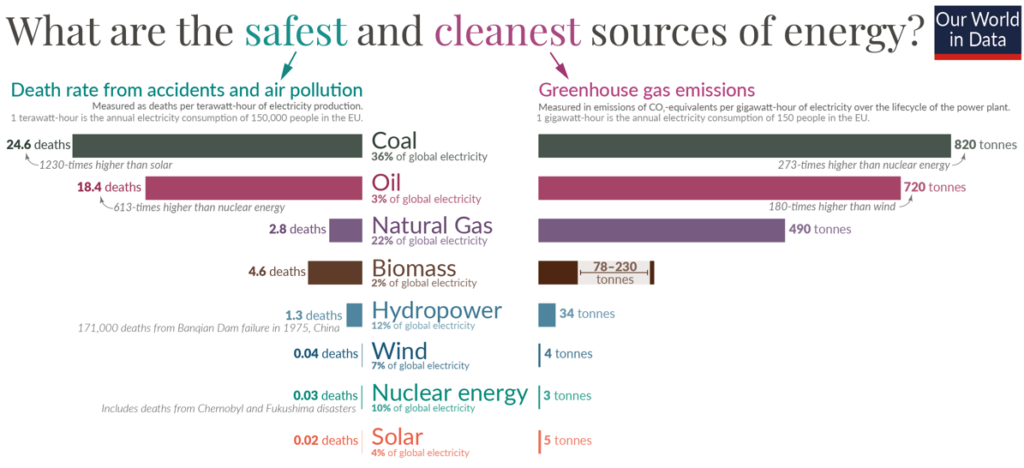The major cause of climate change is the burning of fossil fuels like coal and oil for generating energy. These fossil fuels are finite and not sustainable. This is where renewable energy comes in. Sources like wind, solar and hydro provide a sustainable and environment-friendly energy. This is a crucial way to save our environment from rapid climate fallout, or so we’re told.
In reality, investing in renewable energy lies in the interests of the fossil fuel giants because they know that renewable energy just cannot sustain us and that there will always be a need for a more reliable source of energy like fossil fuels.
We often see only two options; Fossil fuels or renewable energy and see it as a complete black and white situation with one side being a green and prepossessing planet and the other being an inhabitable hell hole, we think that solar, wind, and hydro energy are a hundred percent environment friendly while they’re really not.
Wind turbines help reduce CO2 emissions but their construction produces a lot of CO2 emissions. 80% of them are made by steel and the entire process from smelting to manufacturing produces a lot of CO2 emissions. However, this isn’t the biggest problem since they pay it back in less than a year, the issue is that a low carbon footprint is just about the only benefit of a wind turbine.
Wind turbines kill a lot of endangered species of birds, hundreds of thousands of them are killed every year, over a million bats are also killed by the blades each year. Wind turbines also occupy a lot of space to be built, they have to be built in places where the winds are high and away from cities so the only place left is the ocean or nature. A lot of it land has to be cleared of all vegetation and wildlife for the construction of them and they only produce 3.4 Watts of electricity per meter square, it is estimated that it will take 25% of all the surface land in the UK to build enough wind or solar farms for them to sustain themselves on renewable energy. By destroying huge swathes of nature, aren’t we destroying the very nature the renewables are intended to save?
There are many problems with Solar energy as well, they also produce a very low amount of electricity per square meter. Well made solar panels have a life expectancy of 20-25 years but as they became more popular, lower quality chinese panels flooded the market that only have a life expectancy of around 5 years and many of them contain highly toxic chemicals that are harmful to human health and can cause cancer, the toxicity of these chemicals also never decay. Solar panels can always break with some degree of regularity; when the glass is smashed, these toxic chemicals can reach into the soil and thus public drinking water. We also don’t have a plan to dispose of these mountains of solar panels safely so they’re currently just shipped off to Africa and other developing regions of the world and are just thrown in massive landfills or worse, water bodies. These problems could be fixed with better decommissioning protocols but there is another problem that is inescapable.
Wind and Solar power plants only produce energy when the wind blows or the sun shines. In some locations, that’s only 10% of the time and even the most efficient wind and solar farms only work optimally for 30% of the time which means we will always need a more consistent energy source like fossil fuels or nuclear to cover renewable’s downtime.
So we can’t sustain ourselves on renewables, does that mean we should just stick with fossil fuels? No. As I mentioned before, we think that there are only 2 options; Renewable or fossil but there is a third option that we all seem to despise and fear: Nuclear.
Fossil and Nuclear power work with the same framework, the fuel produces heat which is used to create steam which turns a large turbine, which turns a generator on and electricity is produced. These turbines are absolutely massive and this gives it some benefits. Primiliarly, redundancy. Nuclear power plants produce electricity 24/7 for 365 days of the year and are only shut down once every two years to refuel and when something goes wrong and the plant shuts down, the entire grid doesn’t shut off instantly; there is a small window which allows the national grid to come back online whereas if a wind turbine or solar plant shut down, the electricity is gone instantaneously.
Nuclear power plants produce 1000 Watts of electricity per square meter which is a lot more than any other source of energy and especially renewables.
So why do we despise nuclear energy so much? The public opinion on them is very unfavorable because of 3 main reasons. Firstly, they’re associated with weapons of mass destruction. Secondly, we fear a power plant meltdown will result in a horrifying catastrophe like Chernobyl and thirdly, the media has told us about the risks of nuclear waste and how it is very radioactive.
All of these concerns are simply misinformed and outdated. Firstly, the more power plants we build, the less nuclear bombs exist in the world, over 50% of american nuclear plants run from the fuel of decommisioned nuclear bombs so building more nuclear powerplants will also decrease the risk of an extinction level nuclear war.
We’ve come a long way in terms of Nuclear research and according to statistics, nuclear energy is the safest form of energy. In the graph below, nuclear is shown as the cleanest source of energy but the second safest in terms of deaths. The data is taking every nuclear disaster in the 21st century but it is still the safest in terms of energy produced because it accounts for 10% of the global energy production while solar only accounts for 4%.

Nuclear energy is 100% green and the only byproduct is the aforementioned “radioactive waste”. However, nuclear waste is a hundred percent contained and does not leak into the environment unlike the waste produced by renewables, nuclear waste can also be recycled and reused in reactors multiple times.
It is important to note however, that the uranium mining and enrichment process do use fossil fuels and this does produce CO2 emissions but the carbon footprint of a nuclear plant and its related industries is the same as wind turbines.
However, nuclear power’s carbon footprint could be even lower than wind, be completely meltdown-proof and produce little to no waste. In 1950, Indian physicist Homi Bhabha postulated that perhaps another fuel from the typical Uranium 235 and Plutonium 239 could be used for nuclear fission: Thorium.
Thorium is a naturally-occurring radioactive metal that is four times as abundant on earth than Uranium. After world war 2, a successful thorium reactor was built at Oak Ridge National Laboratory and it successfully generated electricity between 1965 and 1969 but the American government decided that the future of nuclear power wasn’t thorium because it was much harder to produce weapons with it and so every reactor in the world has used uranium since then.
There are many benefits of Thorium as nuclear fuel, a famous chinese scientist claimed that thorium reactors will generate a thousand times less nuclear waste than normal uranium based reactors. They are also naturally enriched so it takes away the CO2 emissions released by the enriching process.
India holds the largest share of Thorium in the world and this could be very beneficial for us to move away from coal and towards actually sustainable energy unlike renewables, it could also develop the Indian economy significantly since we will be able to stop importing energy and we could even start exporting Thorium and electricity.
Currently, 80% of electricity in France is generated by nuclear reactors and so french citizens have to pay a lot less for electricity compared to a nation like Germany that is actively getting rid of their Nuclear plants in favor of renewables while also investing more into fossil fuels because they can’t sustain themselves on renewables.
This doesn’t mean that it has no flaws; Nuclear power and uranium need to be handled very carefully and responsibly and the Indian government has completely failed in this. Some of the oldest uranium mines in India are situated near the Jaduguda village and the residents’ lives have been made into literal hell because of the mine; Birth deformities, cancer, miscarriages and constant illness. This is because of how UCIL (Uranium mining company) handled the mine and its workers. They aren’t provided adequate safety gear, the waste disposal protocol isn’t followed which has caused many water bodies to be contaminated, the only way to save the residents’ lives is to evacuate them but that is not possible since the government refuses to even admit their conditions are a result of careless mining because then they’d have to compensate the victims. An organization called ‘The People’s Movement Against Nuclear Energy’ was established to stop the construction of nuclear plants because of the given health hazards and their peaceful protest was met with tear gas and police brutality. So if we’re going to save ourselves from climate change, there must be a change in the system.
I’ve had a discussion with the founder and face of this movement: Mr S.P Udayakumar and we’ve come to some agreements. Uranium still requires mining and I’ve mentioned the conditions of those mines but they’re not so far from coal mines and we would require far less uranium mining than coal because nuclear is exponentially more efficient in producing energy.
These mines are operated by private companies and they only see profits so cutting corners is expected and is already happening but something as delicate as nuclear energy is the last place to be privatized, perhaps the abolition of private property is the only way to move towards nuclear energy and avoid climate fallout.
Nuclear energy is a long term investment considering how construction of a reactor can take over 10 years and costs billions of dollars. I am not saying that renewable sources are completely useless since it costs a lot less to just build a wind turbine in an isolated town than to connect it with the existing nuclear powered grid, renewable energy provides flexibility which is something nuclear cannot. So an ideal grid would consist of nuclear energy at its core which would power our major population hubs and sources like wind or solar to power remote locations; We also have a lot of hydroelectric infrastructure so integrating that as well would allow us to generate clean energy for everyone.
To conclude, renewable energy isn’t sustainable on its own and we will always need a more consistent source of energy like nuclear or fossil. We must stop investing into renewables to power our population because that is impossible and is exactly what the fossil fuel giants want us to do[2] because it’s the only way they’ll be able to secure a future. Instead, we should focus on nuclear because it is the cleanest, safest and most efficient source of energy we have and it is realistically the only way we can save our planet and ourselves.
This article was part of the series “Climate Change is not Your Fault”




